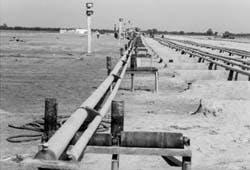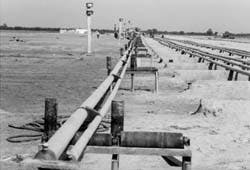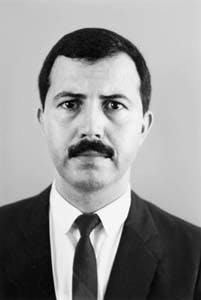PIPELINE TOW CUTS INSTALLATION COSTS OFFSHORE TUNISIA
Scott Hagood
Anadarko Algeria Corp.
HoustonTahar Hajji
Tunisian British Services Sfax,
Tunisia
Ed Perera
ABB Lummus Crest Inc.
Houston
Use of near-surface pipeline tow for installation of flow lines in the offshore Tunisian Cercina oil field yielded a savings over a conventional laybarge operation of more than $3 million and accelerated the project schedule for an earlier completion.
The Cercina field was discovered in 1992 in shallow water offshore Sfax, Tunisia. The field is operated by Tunisian British Services, a joint venture of British Gas Tunisia Ltd., subsidiary of British Gas and Enterprise Tunisienne d'Activities Petrolieres, the Tunisian state oil company.
Field development began in early 1993 with first production in May 1994. Optimization of the development plan and particularly the offshore installation of facilities and pipelines enabled the project to maintain its economic viability.
A prime example of the optimization of the offshore installation was installation of subsea flow line bundles via a series of pipeline tows rather than by a conventional pipelay barge.
The pipe tow operation cost slightly more than $1 million compared to the budget price of S4.4 million for conventional pipelay; savings: $3.37 million, or 77%.
This savings translated into a 32% savings for the project's construction capital.
The Cercina field lies in 614 ft of water within the Kerkennah West Permit offshore Sfax (Fig. 1).
The field was discovered in February 1992 by the Kerkennah North #1 (KKN1) well. Two additional successful wells, KKN-2 and KKN-3 followed this well.
Further appraisal drilling indicated the field was economic, and a development plan was submitted and approved in February 1993.
The plan called for a two-phase development with Phase I consisting of the drilling and completion of 1 0 production wells, each with its own small, wellhead protector platform.
Each well would produce via a 4-in. multiphase flow line to a central production facility for processing with the oil to be loaded on shuttle barges for eventual transport. Instrument gas and, eventually, gas-lift gas, would be delivered to each wellhead via a 2-in. pipeline bundled with the 4-in. flow line.
The goal of Phase I was to achieve early production that would provide a positive cash flow and permit acquisition of reservoir data for additional field studies before commitment of further capital for a larger Phase II development.
The early production scheme would be accomplished with pre-existing, leased production equipment mounted on a submersible drilling barge which would also be leased, thereby reducing the initial capital outlay and time required to design and fabricate new, site-specific equipment.
Development drilling began immediately upon approval of the development plan as did engineering, fabrication, and procurement of process facilities.
Production expectations decreased as the drilling program progressed, requiring a re-evaluation of the work plan to maintain economic viability. The project continued as a minimal, three-well development requiring installation of two pipeline bundles with a total length of 5 miles.
A field layout is presented in Fig. 2.
INSTALLATION PLAN
(Table 1) Offshore installation of the platforms, equipment, and pipelines was envisioned as a typical shallow water project to be accomplished by tendering a turnkey installation to a qualified offshore installation contractor.
Pipeline installation would be accomplished by a small, conventional laybarge to weld and connect the 2 in. and 4-in. pipe then lay the bundles off the rear of the barge. Input from various interested contractors led to a budgeted price of $4.4 million being developed for the pipelay.
A comprehensive tender list consisted of international offshore contractors and smaller contractors from the U.S. Gulf Coast. Evaluation of the received tenders revealed bids that agreed with the budgeted price.
As a result of the emphasis on cost reduction, the project team evaluated the tenders but simultaneously developed and evaluated the concept of performing the installation via a pipeline tow. This method would involve the 2 in. and 4-in. pipelines being prefabricated and assembled as a bundle at an onshore location and then towed to the final location.
A detailed cost estimate, following a comprehensive search for local equipment and materials, reflected the pipeline installation cost via tow to be $2,121,089 compared to the budget price of $4.4 million for a savings of $2,278,91 1, or 52%.
Tunisian British Services submitted a proposal to management that involved pipeline installation via tow with TBS acting as prime contractor, thereby eliminating the requirement for a third-party construction contractor.
This alternative provided several distinct advantages over the conventional, tendered, turnkey installation as detailed below:
- The pipeline tow could be accomplished for a significantly reduced cost. The reduction derived from four causes:
1. Onshore preparation reducing the exposure to inclement weather during fabrication and installation.
2. Reduced-cost effect of low welding rates. Local welding and non-destructive testing (NDT) rates are noticeably lower than those of many other areas.
These low rates would become critical if allowed to determine the rate of progress of an offshore spread. But with the tow method, welding could be performed on shore for a lump sum, eliminating any financial exposure from reduced work rates.
3. Accomplishing the tow with a smaller offshore equipment spread than would be required for conventional pipeline installation.
4. Accomplishing the tow "at cost" if directed by Tunisian British Services. Conventional pipelay by a third-party contractor would require that profit and contingency be added to the job cost.
- The tow could be accomplished with local contractors and equipment rather than by importing personnel and equipment from outside the country. This step reduced costs for mobilization and demobilization and capitalized on local content.
- This procedure provided the opportunity to accomplish a transfer of technology from the experienced project managers to the local staff.
With this being the first pipeline tow executed in Tunisia, there was no locally available knowledge or experience with such an operation. As a joint-venture operating company, one of the goals of Tunisian British Services is to develop local knowledge and expertise.
Management endorsed the pipeline-tow proposal in November 1993.
PREPARATION FOR TOW
Planning for the execution of the pipeline tow required that many technical and logistical problems be considered. Following are the major items addressed during the preparation for the tows:
- The tow method considered would be a near-surface tow as opposed to a bottom tow with the advantages that a near-surface tow requires far less horsepower from the tow vessel and avoids bottom obstacles.
- Selection of a shore site for pipe welding and bundle assembly was a critical early decision.
In this decision, the ideal site would be a steep nearshore region permitting towing vessels to approach near to the pipe string, encompass a small number of landowners with whom to negotiate for the site, afford the shortest possible tow route to the installation location, be readily accessible for the working personnel in all weather, be of proper dimensions and orientation to allow pipe makeup with a direct pull into the sea, and provide a tow route that avoided areas heavily traveled by other vessels.
The site selected for this tow offered a compromise on these attributes.
Ports and harbors use the few locations which have a steep nearshore region. But the selected location required negotiation with only a single landowner, greatly simplifying its acquisition.
Although the site was susceptible to minor flooding from infrequent heavy rains, it offered excellent access to personnel and was located only 15 miles from the city of Sfax.
Additionally, the selected site allowed the minimum possible tow distance from the makeup site to the installation location: the route would traverse a direct path of 15.6 miles through a channel encountering only minor boat traffic.
The site was also proportioned to allow the makeup of pipe sections of 1,345 ft long.
Fig. 3 presents a pipe bundle-makeup site plan.
ROUTE SELECTION
The desired tow route was to be a direct line between the pipe-makeup site and the offshore field, minimizing the required tow distance. A pre-tow survey, conducted with an echo sounder and side-scan sonar, examined a 245-ft wide corridor.
Although no bottom-founded obstacles were identified, the presence of a shoal surrounding the field with a slightly deeper entrance channel was noted.
The final tow route, adjusted to make use of this channel, totaled 15.6 miles.
The pipe required neutral or positive buoyancy during the tow.
Negative buoyancy would have resulted in a bottom or off-bottom tow damaging the fusion-bonded epoxy (FBE) coating and possibly fishing nets.
The 2 x 4-in. pipe bundles exhibited a 1.78 sp gr; therefore, additional flotation was required to achieve positive buoyancy.
Following a search of the Mediterranean Sea area for suitable purpose-built flotation devices, it was decided to fabricate them locally by obtaining commercial plastic drums (locally manufactured and readily available) and subsequently filling them with polystyrene for added strength and to provide flotation in the event a drum was punctured during a tow operation.
Calculations indicated that the drums would be required every 20 ft adequately to support the pipe, thus providing a final towing 0.98 sp gr.
Locally manufactured flotation provided a distinct cost reduction: They had a total manufactured price of $13,400 compared to a purchase price of $33,800 for available purpose-built devices.
These savings, while not large, demonstrate that savings were obtainable at all levels of the project.
PIPE MAKEUP
As discussed, the selected pipe makeup site offered extremely shallow water for several hundred meters offshore. Thus, the towing vessels were restricted in the area where they could approach the pipe pulling head.
No vessel of sufficient horsepower could approach close enough to pull the pipe into the water. To overcome this dilemma, a series of rollers was fabricated and installed as a launchway leading into the sea.
Additionally, a "deadman and sheave" were placed at the forward end of the pipe launchway so that a tractor could pull/push lengths of pipe offshore until the tow vessel could take over. Two small fishing boats were hired daily to assist the tractor and pull the pipe to deeper water.
Calculations indicated that the force required to initiate movement of a dry, 1,345-ft, welded pipe bundle along the launchway rollers was 7 kips (1 kip = 1,000 psi).
The force required to execute the actual tow was far less than that required to initiate movement because roller friction during the launch was the controlling parameter for the operation.
The fishing boats hired to assist pulling the pipe into the water possessed minimum 35-hp engines. The local tidal fluctuation is approximately 1 m.
Planning for the tow recognized that the towing vessel must traverse a 6-ft shoal upon entering the field.
Therefore, the timing of operations was established so that the vessel with pipe would depart the pipe makeup site 1 hr before the forecast high tide so that entry to the field would occur during high tide.
In practice, it was found that during high tides, water would reach the end of the pipe launchway, while during low tides, the water might stop 1,500 ft from the launchway.
With this fluctuation and the gradually sloping nearshore, it was imperative that the pipe-launching operation be conducted during rising and high tides.
It became apparent that launch was more tidal-dependent than the actual tow. Therefore, the tow vessel was specified to have a maximum draft of 5 ft, and the timing of the operation was adjusted accordingly.
With semidiurnal tides at the launch site, it was observed that approximately 3-3.5 hr were available during rising and falling tides when there would be sufficient water to conduct the pipe-launch operation.
TOW EXECUTION
Before the pipe tow, a simulation was carried out to examine the behavior of the pipe bundle, particularly the rigging and floats, under varying conditions of tow speed and wave height.
The simulation was accomplished by assembling one 40-ft bundle of the 2 and 4-in. pipe complete with the flotation drums attached. Once assembled, the bundle performed with expected buoyancy with the flotation partially submerged, placing the pipe approximately 18 in. below the water's surface.
The bundle was first towed on a calm day with ropes, flotation, and pipe all behaving as anticipated. A second tow simulation used 5-ft seas created by the wake of a crew boat to demonstrate the most severe sea state anticipated.
Again, the pipe bundle behaved as expected, promising that the actual tows could be achieved without difficulty.
When the operation began, the pipe was strung perpendicularly to the sea in 1,345-ft lengths where it was welded and radiographed. Coating-holiday detection and required repairs were carried out during application of the field-joints' coating materials.
Following this operation, the pipe was pigged in-place with foam pigs driven by air to remove sand and other debris before installation. Anodes were added and, finally, the pipe strings were bundled with rubber saddles.
Before pipe launch, two pipe bundles were placed on the launchway rollers where the flotation drums were attached.
Plans called for the tow to begin by the launching of one bundle with assistance of a tractor. When sufficiently far off the launchway, the tow vessel would take the tow rope and continue to pull the first bundle into the water.
When the end of the first bundle approached the final roller, the tow vessel would stop while tie-in welds were completed, radiographed, and coated before the offshore pull recommenced. The tow was to be completed to the field with a 2,690-ft pipe bundle.
In practice, the launching operation using the tractor required approximately I1.5 hr per pipe bundle, consuming valuable time during the high tide period. The tie-in was expected to require a minimum of 2 hr to complete the welds, perform the radiography, and apply field-joint coatings.
Therefore more than 3 hr would be required to execute the launch.
As 3 hr was the maximum time permitted by tidal conditions for completion of the pipe launch, it was decided to tow pipe bundles of 1,345 ft and perform all tie-ins offshore.
Using the semidiurnal tides allowed the launch and tow to be conducted during daylight conditions. Each pipe section's being 1,345 ft long would result in 20 field tie-ins rather than 10 as originally planned.
Following the practice of the simulation tow, the initial tow consisted of only a single 1,345-ft bundle. The configuration included a swivel to prevent any tendency of the bundle to rotate.
When this initial tow proved successful, TBS decided to tow two bundles but without a tie-in weld. This was achieved with a connection consisting of cable, shackles, and a second swivel.
With the exception of days with adverse weather conditions, the tow rate of 2,690 ft/day was maintained through completion of the tow.
TBS attempted a tow of three strings, but this proved impossible because of the time required to position the third bundle in the launchway and complete the cable and swivel connection. During each attempt at three bundles, the tide began receding before it was possible to complete the tie-in of the third string.
Adverse weather conditions affecting the tow generally consisted of strong long-shore currents with a complementary wind. This would have the effect of pushing the pipe end off the launchway rollers and parallel to the shore because the shallow draft fishing boats had insufficient power to maintain the pipe string on a course perpendicular to the shore and direct to the waiting tow vessel.
Once TBS completed the launch, the pipe bundle was unaffected by weather until it reached the laydown zone. With this being a near-surface tow, the flotation drums were only partially submerged with 50-75% of the drum surface exposed above the water.
It became difficult to position and submerge the pipe under strong wind conditions as the flotation drums tended to capture the wind and act as a sail.
ROOM FOR IMPROVEMENT
TBS accomplished the pipeline tow operation with no significant problems. Any operation, however, can be improved for future similar operations.
Areas of potential improvement exist in relations with local fisherman and with launching the pipe.
It was necessary to charter several small fishing boats both to assist with pulling the pipe offshore and to escort the tow to ensure no interference from other boat traffic.
Although these operations were carried out successfully, other fishermen whose boats had not been chartered attempted to disrupt the operations by placing nets or anchor lines across the tow route.
Before future similar operations, an effort will be undertaken to work more closely with the local fishing community to avoid similar incidents.
As described, the time-consuming launching of the pipe limited the number of pipe strings which could be towed in a single operation. Several modifications might lead to a speedier launch of the pipe:
- Construct a launching ditch through the shallow near-shore region and up into the shoreline which will have the effect of providing a steeper nearshore region and eliminating the dependence upon high tide for the launch.
- Modify a few of the rollers to incorporate small, electric motors which then act as a conveyor to push the pipe offshore without the assistance of tractor and deadman arrangement.
- Install a deadman far offshore which will permit a continuous pull of the pipeline bundle as in a conventional shore approach.
The towed installation greatly accelerated the project schedule. The contractor offering the lowest bid proposed a construction schedule with installation to occur during the summer of 1994; the towed installation was completed by May 15.
Copyright 1995 Oil & Gas Journal. All Rights Reserved.




